Bird Calls And Songs
Bird Calls And Songs: The Complete Guide To Various Bird Sounds
Bird song is one of the wonders of the natural world. It has uplifted and cheered human beings for as long as history has been recorded. Yet its beauty continues to charm us more than ever in this modern technological world.
Most urban homes play host to some song birds… and to hear the dawn chorus at the same time as watching the sunrise is a truly beautiful experience.
Birds however, do not sing to charm humans. Song birds evolved around 60 million years ago, long before any humans were around to listen.
For birds, songs are a means of communicating with other birds (as are bird calls).
The Syrinx: How Birds Make Sound
Birds do not have a larynx like we do. Instead they have an organ called a syrinx.
The syrinx is located much deeper in the bird’s body than our larynx is and for many years scientists had little idea how birds actually made sound. Even today there is a lot we do not know.
However – by dint of making birds do lots of unnatural things – like sing with fibre-optic scopes down their throats, sing in a helium-oxygen atmosphere or sing with their beaks held open (while watching them with infra-red and x-ray cameras), scientists have learned a little about how this amazing instrument works.
A bird’s syrinx is a double instrument that sits deep in a bird’s chest at the point where the trachea divides into two bronchi. A
This means that a bird can sing two different notes at the same time, or even sing a duet with itself.
Some birds such as thrushes do exactly this. They are even capable of singing a rising note with one side and a falling note with the other. Other birds use their dual vocal chords in different ways, such as using one side for low notes and the other for high ones.
Cardinals can switch from one side to the other in mid-note, while canaries breathe through one side and sing with the other.
Cowbirds sing very rapid notes one alternately from each side. It is this sort of ability that allows some birds to sing as many as 30 separate notes per second.
Imitating human speech is a difficult trick and parrots and their smaller kin – the budgies – use different techniques.
Parrots have thick tongues, like humans – a novelty among birds. This has the side effect of allowing them to form the sounds of words in a manner similar to us. That means they emit a preliminary sound from their syrinx and then modify it using the mouth, throat and tongue.
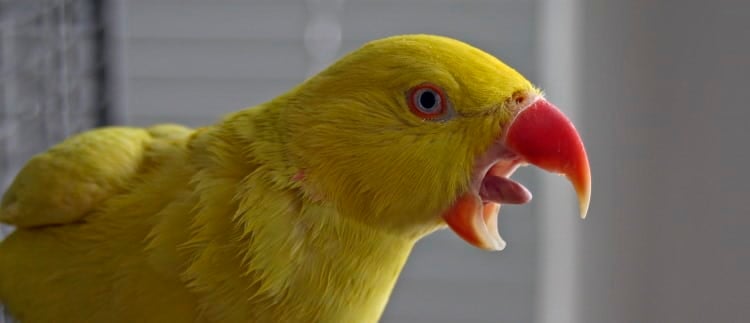
Budgies, however, are too small to do things like this. So they use their syrinx to create a 2-3 Kilohertz carrier frequency then add a second vibration to it.
This is a well-known scientific system called frequency modulation and is the principle behind AM radio. However, how budgies actually do it is still a mystery… so do not worry if you haven’t understood this section too well.
Bird Calls
Not all birds sing and not all the sounds birds make are called songs.
Singing is limited to the order Passeriformes, or perching birds. This means that nearly half of the birds in the world do not sing. They are not, however, silent. Far from it, nearly all birds use sounds to communicate.
Most birds use vocalisations which are short and unmusical and cannot be termed as song. These sounds have considerable functionality and are generally labelled call notes or calls to distinguish them from true songs.
Bird Calls can be divided into at least 10 different categories:
- General alarm calls
- Specialized alarm calls
- Distress calls
- Aggressive calls
- Territorial defence calls
- Flight calls
- Nest calls
- Flock calls
- Feeding calls
- Pleasure calls
Not all birds use these calls and many birds have more than one call for one category.
To confuse matters even more, some birds seem to use very similar calls in different circumstances to mean different things. Nevertheless, most birds seem to have between 5 and 15 distinct calls that ornithologists can recognise.
Generally speaking, the passerines have a greater repertoire of bird calls than non-passerines.
Number of Bird Calls as Adults
| Non-passerine Birds | No. Calls | Passerine Birds | No. Calls |
|---|---|---|---|
| Barbary Dove | 5 | Wren | 12 |
| Fowl (chickens) | 6 | Blackbird | 11 |
| Herring Gull | 7 | Chaffinch | 13 |
| Doves (other) | 9 | Song Sparrow | 14 |
Pleasure calls are unique to juvenile fowls, while wrens and blackbirds have a special roosting call which Chaffinches and Sparrows do not have.
It is not uncommon for birds to have at least 3 or more alarm calls, one of which will only be used to signify an aerial predator, i.e. a Sparrowhawk.
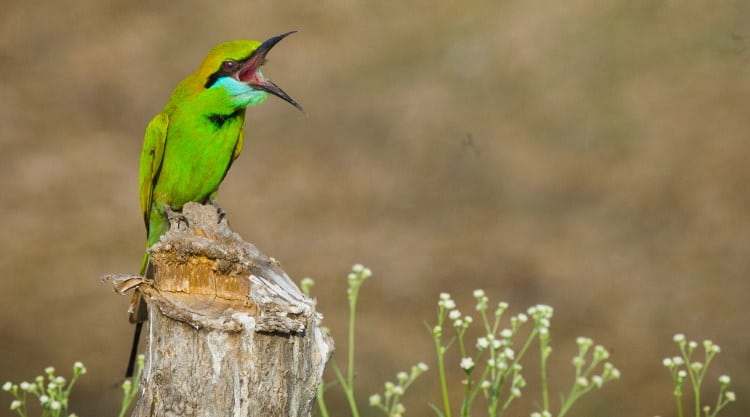
Alarm calls give information to other birds nearby. This applies not only to members of the same species, but also to other species of birds. There is considerable similarity in the alarm calls of a wide variety of birds, which makes it easier for birds of different species to recognise – and respond to – each others alarm calls.
Distress calls are restricted to juvenile birds and generally serve to bring an adult to the rescue of a young bird in danger. Begging calls are also used only by young birds. Basically, they are a young bird’s way of getting an adult bird to feed it.
On the other hand, courtship, copulation, mate feeding and territorial calls are all used only by adult birds.
Flight calls are used immediately before and during flight and serve to help keep the flock co-ordinated. Some birds have a variety of flight calls including one for commencing flight, one for ending flight or staying still and one or more used during flight.
All these calls act as a simple language, allowing birds to communicate with each other and with the rest of the world.
In many environments the alarm calls of birds warn other animals of approaching danger. Though the calls a bird can make are controlled by its physiology and genetics, the calls it responds to are largely a matter of learning.
Thus Turnstone chicks reared by a Redshank (Trenga tatarius) respond to Redshank calls and not Turnstone calls.
Sound is often more important than sight in parent-offspring recognition.
A deaf female turkey is unable to recognise her own chicks and chickens cannot recognise silenced chicks (with a belljar over them). Experiments have also shown that, in colony nesting birds at least, young birds can recognise their own parents by their calls alone… though they all sound the same to us.
Birds start using calls early in their lives, in some species even before they are hatched.
Quail chicks use calls to communicate with each other and their mother, from inside their eggs. This way, they are able to synchronise their hatching so that they all emerge from the eggs within the space of a couple of hours.
Pelican chicks tell their mum if they are too hot or cold from inside the eggs. Chicks also listen to their parents while inside the eggs. This way they come to recognise their parents, even before emerging form the eggs.
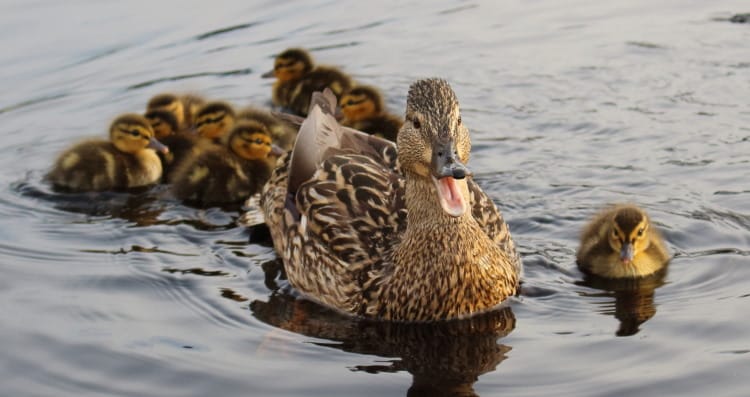
Some birds, such as Mallards, have special maternal calls they give while incubating the eggs, so that after hatching the mother only has to give this call to have the chicks rush to her for protection.
Not all young birds learn to recognise their parents – or vice versa – immediately. In Herring Gulls, about 5 days pass before this recognition takes place, while Kittiwakes take up to 5 weeks for recognition to register.
Birds also distinguish their mates by call.
Gannets are colony nesting birds and a nesting site can have thousands of birds coming and going in a noisy melee that would befuddle a human listener. Tet gannets can distinguish the calls of their particular mate from all those around them, on the basis of only a tenth of a second of the total call!
Bird Songs vs Bird Calls
Birds sing songs as well as give calls.
Songs are constructed differently and serve a different purpose to calls. It is bird song which has captured the hearts of human beings.
Bird songs and singing is limited to only one order of birds, namely the Passeriformes. Even then, not all passerines sing songs and probably less than half the birds on the planet are genuine songsters.
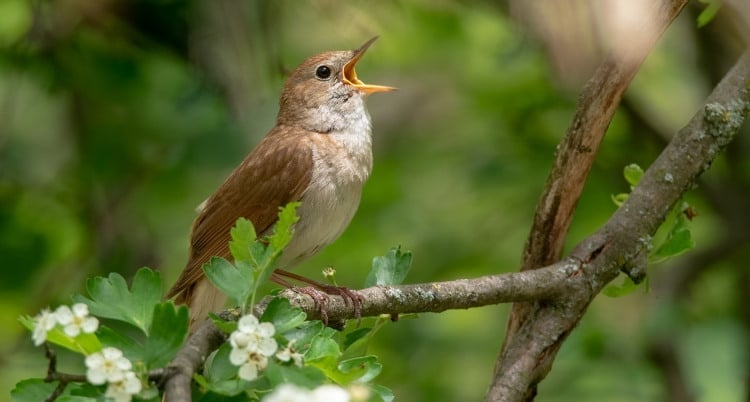
The most famous song bird is the Nightingale (Erithracus megarhynchos). Writing in Rome, before the time of Christ, Pliny said of the Nightingale:
“There is not a pipe or instrument in the world that can produce more music than this little bird does out of its throat”
Later Alfred Lord Tennyson declared:
“The music of the moon leaps in the plain eggs of the Nightingale”.
Learning songs and singing them is not easy for birds. They are much more complex than bird calls.
In fact the feats birds produce for their small size are quite incredible.
The European Wren (Troglodytes troglodytes) sings a song that contains 740 different notes per minute and which can be heard more than 500 metres away.
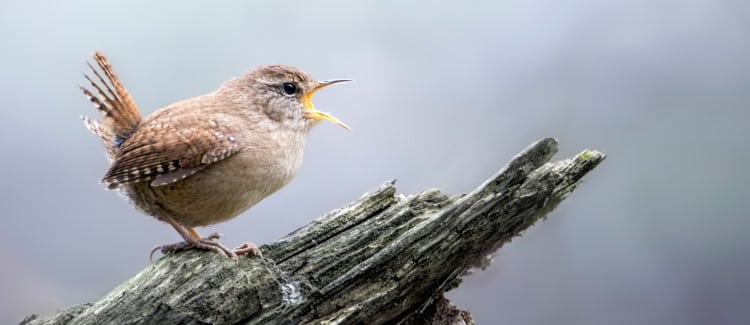
Considering the comparative sizes of you, me and a wren – this is the equivalent of us singing a song that can be heard 4 or 5 miles away.
Birds put an awful lot of energy into their singing. According to some estimates, singing in some birds is as energy expensive as flying.
And birds do not just sing their songs now and then. Some birds sing practically non-stop through the breeding season.
In Europe the Yellowhammer (Emberiza citrinella) sings its ‘little bit of bread and no cheese’ song over 3,000 times a day. In North America however, there lives a really hard working songster: the Red-eyed Vireo (Vireo olivaceus) has been recorded singing ‘see me-hear me’ 22,197 times in a single day. It is nearly always the males who sing.
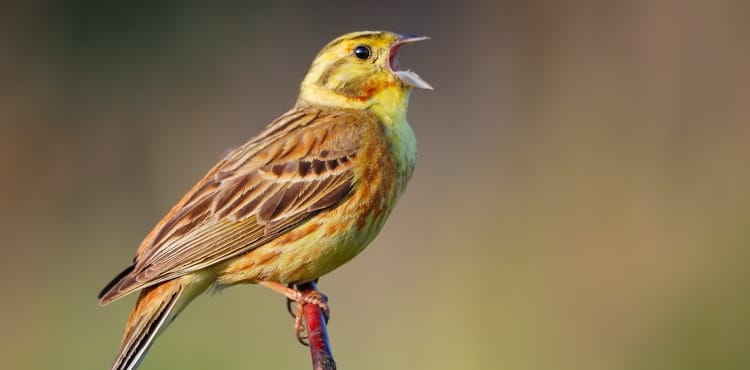
Birds don’t all sing all day, or all year though. How birds choose when and where to sing is an important aspect of bird behaviour.
Where you sing depends on who you are singing to and where you live.
Male birds that are trying to attract a mate need to be sure that females can hear their songs as easily as possible.
As well as being heard however, a male bird needs to stay alive. For this reason you will see that different birds adapt different strategies. Thus the European Robin (Erithracus rubecula) can usually be seen singing from a prominent post, while Wrens give their renditions from well within the scrubbery.
Sedge Warblers (Acrocephalus schoenobaenus) will climb slowly up a reed singing, as they work their way up to the top – before suddenly flitting down to nearer ground level again.
The Science Of Bird Song
Bird song is sound and – like all sounds – it obeys some basic physical laws.
Firstly, it attenuates or decreases in proportion to the square of the distance travelled from the source. Secondly, it can be absorbed and/or reflected by physical objects – even such tenuous physical objects as the wind.
Different wavelengths of sound (higher or lower sound) are absorbed and reflected to a lesser or greater degree by different objects. Scientists have done a lot of research into this sort of thing and they know that in a deciduous or tropical forest, the best ‘sound window’ occurs between 1.5 kHz and 2.5 kHz.
This means that sound in between these wavelengths survives and travels better than sound with higher or lower frequencies. Another complication is that this only works if the bird is at least 1.5 metres above ground level.
Surprisingly, in coniferous forest, transmission of sounds between 1 and 3 kHz is enhanced by the vegetation. Naturally enough, in an open grassland there is no real window. But things like the sun heating the ground and the air change the way sound travels. However, height helps sound to travel further before it is all absorbed.
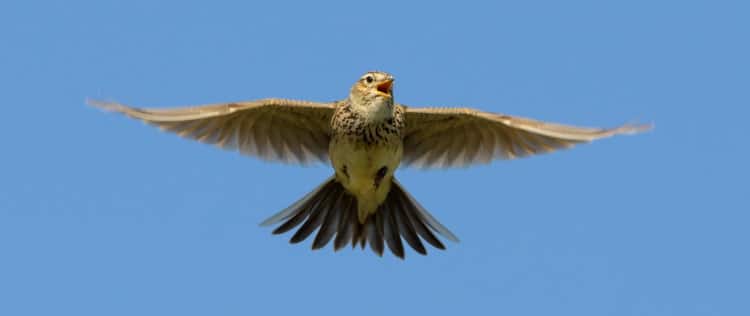
So many grassland birds like Skylarks and Pipits sing ‘on the wing’… often making ‘song flights’ to heights around 3-6 metres above ground level.
One of the most amazing facts emerging from studies of the physical properties of bird song was the discovery that some birds like the Carolina Wren (Thryothorus ludovicianus) can judge how far away another male bird is singing, not by the volume, but by the amount of degradation that the bird song has undergone between its source and their hearing it.
Why Do Birds Sing?
A bird singing to keep other males out of his territory also needs to be heard.
However, he will often sing less intensely if this is his only reason for singing!
Some birds like Reed and Marsh Warblers (Acrocephalus ssp.) sing less often, less intensely and less complicated songs after they have acquired a mate – while Sedge Warblers stop singing altogether.
The European Robin, on the other hand, sings all year round. We can hypothesise then that territory maintenance is more important in the non-migratory robin than in the migratory warblers.
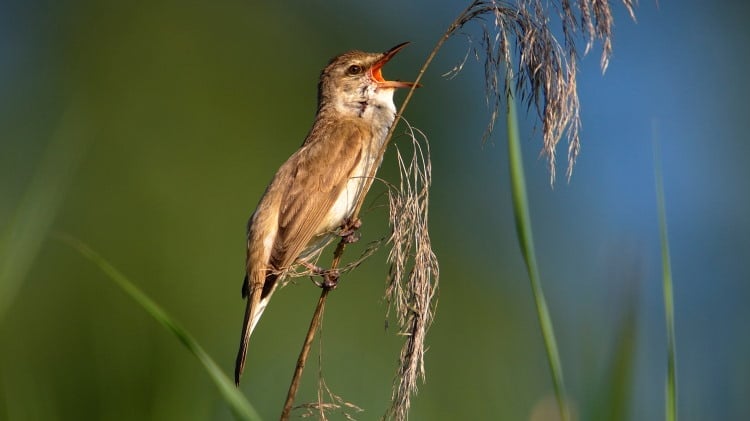
Research into warblers in Europe has shown that females prefer males with more complicated songs.
Research also shows that in most birds the presence of a singing male is enough to maintain a territory. In other words, the male’s song is a bit like a sign saying ‘This territory is occupied and the owner is home’.
Other male birds then respect this. In most cases the resident bird wins any confrontation – possession is at least 9 tenths of the law in the world of birds.
The male sings for two reasons then: to proclaim to other males that this is his territory and to attract a mate. Often both these purposes are served by the same song.
Not all birds sing as much as warblers and robins, however.
The dawn chorus is a well-known phenomenon and has strong ecological reasons for its existence. The time just around dawn, on the edge of a woodland, is a good time to sing because the air is normally still and sound transmission is good. It is also a time when many of the daytime predators are not on the move yet.
Thirdly, for insectivorous species, food is not easy to find until later in the day when the air has warmed up. Fourthly, many female birds, such as tits, lay eggs in the morning – and the best time to mate is in the hour before the eggs are laid.
A male then is getting the best of several worlds if he sings well enough to attract a mate.
The female can benefit as well because the quality of a male’s song depends partially on the amount of feed he had the day before. So a male who sings well after a cold night with no food is likely to be good at finding food and therefore worth mating with.
Though some birds sing relatively simple songs, others have more complicated ones involving many different phrases.
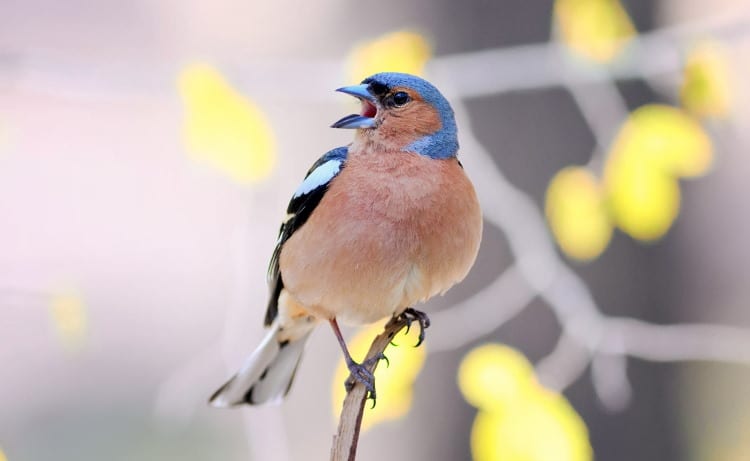
Some birds, such as Chaffinches (Fringilla coelebs) may have several – usually about 5 – different songs they can sing. It seems that in species with complicated song, the females are turned on by the complexity of the song.
Males with more complex songs therefore find mates earlier in the season.
Getting the pair bond formed early in the season is important because the sooner the pair can start raising a brood of young, the higher their chances of successfully rearing a second brood… and thus increasing their reproductive success.
How do Birds Know What to Sing?
Where do birds get their song from?
Research has shown that it is a mixture of innate, pre-programmed knowledge of what their species’ song is and learning from older singing males.
Birds of various species such as Chaffinches and the White-crowned Sparrow (Zonotrichia leucophrys) will develop a song, even if raised in complete isolation. But the bird song will be deformed in comparison with normal, wild song for that species.
Scientists believe that birds are born with some innate capacity to develop a song, this is called the Auditory Template Theory. This template is modified and perfected as a result of practice and listening to older birds singing.
Some species of birds show definite learning skill. They sing a song that is a bit of mess at the beginning of their first season, but after a couple of weeks of practice become much better at singing the species’ anthem.
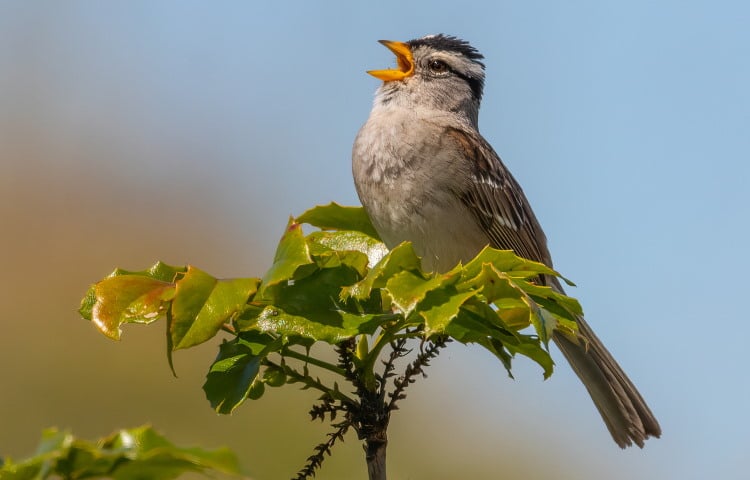
This early song is first called a ‘plastic song’. Plastic song evolves into ‘pre-adult’ song, which in tern becomes full adult song. There is much variation between species though. Some species have such a strong innate template, that they cannot learn anything else. Others learn whatever is available and can be taught the song of other species.
In the wild though, these birds learn from their own species.
Finally, some birds learn – even in the wild – from other species. Starlings (Sturnus vulgaris) for instance will copy the whistles of various shore birds, as well as the sound of other songbirds, even mechanical sounds and incorporate them into their song.
The greatest song mimics though are the Marsh Warblers. Scientists have recorded and distinguished bird calls from over 200 other bird species being used by Marsh Warblers, though not all by the same bird.
A further interesting fact concerning bird song and learning is that because birds learn from each other they tend to develop regional dialects just like people!
This is much more evident in non-migratory species.
Bird watchers around San Francisco Bay area can place a White-crowned Sparrow to within a couple of miles of its home range on hearing its song.
These dialects are maintained because females tend to prefer males which sing the local dialect and because – though birds from the centre of a particular dialectal range disperse outwards in a circular radiation – those near the edge tend to disperse in towards the centre of the range.
To Sum Up
Male birds put a lot of effort into learning, perfecting and singing their song.
They do this for two reasons, firstly to keep other males out of their territory and secondly to attract one or more mates.
There is a lot of variation within this simple scenario between species. The limits of this variation are defined by the physical properties governing sound transmission, the environment the bird lives in and the degree that song form is linked to reproductive success as a secondary sexual characteristic.
Other Bird Sounds
Birds use sounds other than those created by their vocal chords.
Sounds can be created by stamping – as in Coots – or by clacking the mandibles together, as in Frigate birds, Albatrosses and Storks.
Birds also use their wings to create sounds, simply by clapping them together – as the wood pigeon – or by having modified feathers which vibrate at a set frequency when exposed. Snipe use this during courting. Two feathers on either side of the tail vibrate as the bird falls out of the sky.
Other birds which make sounds with their wings include Mute Swans, Broad-tailed Hummingbirds, Bellbirds and the New Zealand Tui.
Perhaps the best known of these percussive sounds is the drumming of woodpeckers. Each woodpecker, in those species tested, has its own drumming pattern – so male and female birds can easily recognise each other while they are out foraging.
The most unusual, however may be the Palm Cockatoo which makes drumsticks from twigs and beats them against a hollow log in time with a pirouette during courtship.
Several species of cave dwelling birds use echolocation (similar to bats) to detect objects around them in the dark.
Swiftlets from S.E. Asia – also known because some of them produce the nests used in making bird-nest soup – use sounds with a frequency between 4.5 and 7.5 kHz to navigate in the caves they nest in.
Oilbirds in South America also nest in caves and use sounds in a range between 1.0 and 15 kHz, emitted in staccato bursts, to navigate inside the cave. Unlike the Swiftlets, Oilbirds are nocturnal but they do not use their echolocation outside of the cave.
The sounds both these species use are audible to the human ear. Sounds caused by a flock disturbed by a human intruder into their nesting caves have lead to many tales of devils and demons.
The echolocation of both these species is considerably less efficient than that of bats because the sounds are lower and therefore have longer wavelengths.
This means that they cannot distinguish smaller objects. Oilbirds cannot, apparently, detect anything smaller than about 15cm diameter, while Swiftlets have a lower size limit of about 6 cms diameter.
Final Thoughts
As you can tell, the world of bird calls and bird song is one of virtually infinite complexity. It is surely worthy of further study!
Video Credit: Australian National University

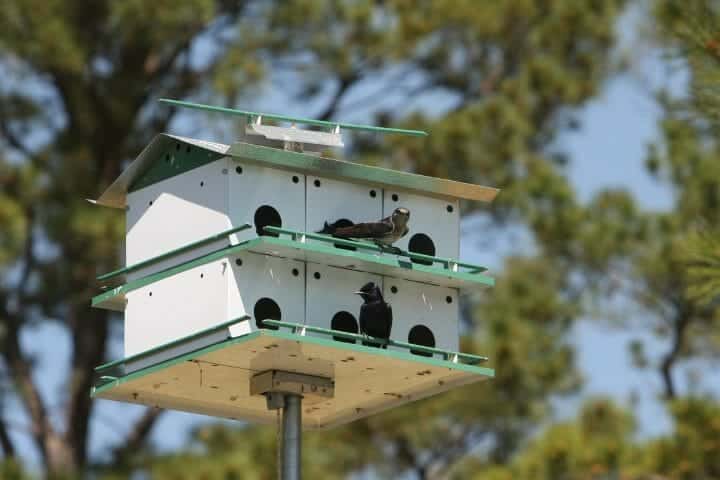
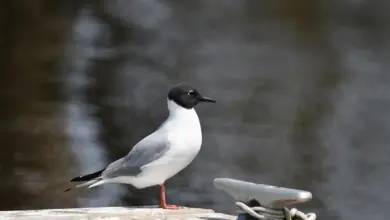


Thank you! Very thorough and incredibly detailed. Many congratulations and thank you once again. Cheers
Hi Gordon, Wonderful website and info about bird sounds! I was wondering, do you have a full dataset of that table with number of bird calls in passerines and non-passerines? And the literature references of that? If you do, could you please email it to me? Keen to chat. Thank you!
Hi Loo Yen Yi, Sorry I cannot help at the moment, I and my library are stranded far apart at the moment, and as I wrote that nearly twenty years ago, I cannot even remember the source.